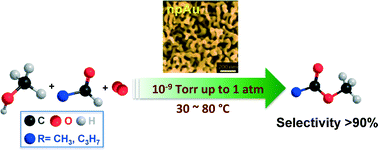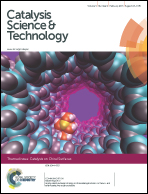Abstract
The oxidative coupling reaction of aldehydes with methanol occurs in the vapor phase over a support-free nanoporous gold (npAu) catalyst over a wide pressure range—from 10−9 Torr to 1 atm. The dependence of the aldehyde-to-ester reaction rate on the oxygen, methanol and aldehyde partial pressures suggests that the rate-limiting step for coupling is the reaction of the aldehyde with surface sites saturated with adsorbed methoxy. Stable catalyst activity is achieved for aldehyde–methanol coupling in flowing reactant mixtures at 70 °C. While the conditioned npAu catalyst exhibits high selectivity for methanol–aldehyde coupling, its activity for the self-coupling reaction of methanol to methyl formate is reduced by the exposure to the alcohol–aldehyde mixture in a manner that is consistent with the buildup of spectator species. The activity for methanol self-coupling can be regenerated by extended exposure to flowing methanol, CO and O2 at 70 °C. Overall, the observed catalytic esterification is consistent with model studies of both the npAu catalyst and single crystal gold in ultrahigh vacuum.



 Please wait while we load your content...
Please wait while we load your content...